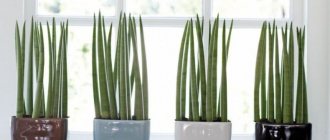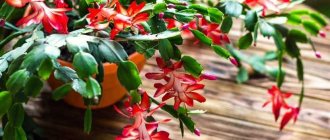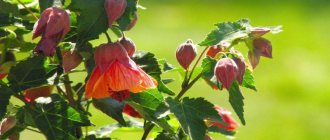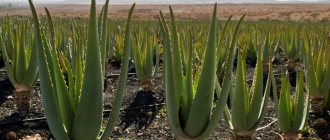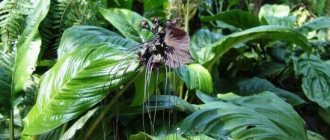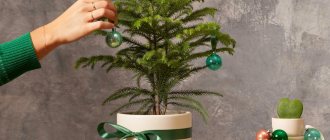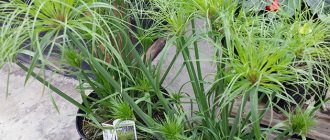General information about fittonia
| Family | acanthaceae |
| Origin | South America |
| Lifespan | perennial |
| Bloom | yes, except for hybrids |
| Shade tolerance | light-loving plant |
| Virulence | No |
| Price | 100-250 rub. |
Initially, Fittonia was grown exclusively in winter gardens or greenhouses, as it died under room conditions. But the work of breeders made it possible to adapt the finicky plant for home maintenance.
The size of the flower and environmental requirements allow it to be used in florariums. For this:
- select a glass container with a lid;
- add drainage and substrate;
- Water thoroughly;
- plant Fittonia;
- complement the composition with pebbles or decorative figures;
- close the florarium;
- after condensation appears, remove the lid for 1.5-2 hours.
After 10 days, the microclimate inside will normalize.
When growing Fittonia in a florarium, make sure that it does not rest against the walls and replant it every six months.
But the closest place to natural conditions for growing Fittonia is the paludarium. This is a special aquarium that imitates a swamp. Here the plant can be kept in a terrestrial, semi-submerged or underwater state. The main thing in this method is to choose the right container and equipment that can maintain the required level of light and humidity. The composition should be supplemented with fountains, decorative figures, as well as plants with similar environmental requirements - aglaonemas or alocasia.
The magical properties of the fittonia plant
Among the magical properties of the flower, its special influence on humans is highlighted, helping in the following areas:
- decide on the right aspirations;
- learn to protect yourself from daily worries and bustle;
- classify desires, choosing the most relevant ones;
- consider priorities;
- gain courage and determination to face change.
According to legend, fittonia is a flower that will help clear the mind
The energy of Fittonia is light, not oppressive, it will direct the owner to find his destiny, so that a person can do what he loves, bringing benefit to the world. It is often recommended to students to calm their minds and open them up to calmly receiving and easily assimilating new information.
As for the family atmosphere, it will broaden the horizons of the household, pushing them towards new hobbies and activities. It is noteworthy that superstitions say that a person who grows this plant will soon achieve success, forgetting about stereotypes.
Description and flowering
The leaves of the flower are ovoid with a pointed tip, located on thin short shoots, making the plant look like a carpet. The color varies from light green to dark emerald. A distinctive feature of the leaves is a mesh pattern formed by white, red or pink veins. An adult flower reaches a height of 10 to 40 cm.
At home, the culture rarely blooms. The buds are small and dim. Most often grayish-yellow or yellow-brown. It is recommended to trim them, since their formation takes a lot of energy from the plant.
Which zodiac sign does she suit?
Fittonia is a true flower of Aquarius, a lover of change and unexpected twists of fate. Representatives of this zodiac sign are distinguished by their love of freedom, friendliness, original taste and outlook on life, which often differ from the generally accepted ones. Since the well-being of Aquarius depends on his mood, fittonia is the best decorative crop that has a positive effect on the state of mind and instantly relieves the blues.
Women who like to grow flowers feel an invisible connection when they see fittonia. The flower lives in their home for a long time, looks great and fits harmoniously into the interior. Its energetic influence has a positive effect on thoughts, character and lifestyle. Always in a good mood helps to attract fans and helps to establish useful connections.
Men who feel the energy of the flower are more likely to achieve success and foresee the consequences of their actions. They notice that their ideas are not only original, but also find like-minded people. Since the goal of Aquarius’s work is not always money (he can work for an idea and its future implementation), a flower with thick “hair” will help attract material values. Being more often at home, Aquarius will not feel the infringement of the settlement. It will be easy for him within four walls, even completely alone.
Microclimate
| Characteristic | Optimal value |
| Temperature | 20-25˚С, no drafts or temperature changes. |
| Humidity | Increased throughout the year. |
| Lighting | Photophilous, does not tolerate direct sunlight. In winter it is necessary to supplement the lighting with phytolamps. |
You can maintain the required level of humidity by using a tray with wet expanded clay or moss, as well as regular spraying.
Choosing a place for a flower
Windows on the western or eastern side will provide the fitton with the necessary diffused light. But it is better to choose a well-lit place in the back of the room. Please note that the flower cannot be left near radiators and open windows.
Benefits and harms
"Fittonia" is not poisonous and cannot harm either children or animals. It cleans the air well, moisturizing it. It is believed that the flower relieves irritability and tension in family relationships.
There is a great variety of indoor and garden ornamental plants. You can find many of them on our website. Among them are Abelia grandiflora, indoor liana anredera, kufeya, a representative of the myrtaceae leptospermum, the exotic perennial colocasia, as well as irezine, butcher's broom, hypocyrta, alternanthera and dizitogotheca.
Priming
- Characteristics: nutritious, loose, able to retain moisture.
- Composition: humus, peat, leaf soil and sand in a ratio of 1:1:3:1.
- Drainage: expanded clay, pebbles, broken brick.
You can prepare the substrate yourself, but with this method there is a possibility that the soil will not be suitable due to the content of any impurities. In the store, choose a specialized substrate for fittonia.
Expert opinion
Mokhov Andrey Petrovich
Graduated from KubSAU, specialty: agronomy
Before planting, disinfect the soil: freeze or heat it. Additionally, saturate it with a solution of potassium permanganate.
Reproduction
Fittonia is propagated by apical cuttings. They can be collected during pruning, the main thing is that the shoot has at least three leaves up to 7 cm long. A moist substrate or settled water is suitable for rooting cuttings. At the same time, its level in the container should not be higher than 1 cm. The shoots must be kept in greenhouse conditions at a temperature not lower than 25˚C.
To do this, it is recommended to use cellophane or a glass container. It is important to carry out regular ventilation and spraying. After about a month, the “cap” needs to be removed, and later, when the plant gets stronger, transplanted to a permanent place.
Expert opinion
Mokhov Andrey Petrovich
Graduated from KubSAU, specialty: agronomy
Fittonia is also propagated by dividing the bush during transplantation.
The flower is easily propagated by layering. To do this, the shoot must be covered with earth. After some time, roots will appear. After they are strengthened, the plant can be separated from the parent and replanted.
Growing Fittonia at home
In a pot
This method is classic. Fittonia is planted in a wide flower pot with sides up to 7 cm high. Expanded clay, possibly finely broken brick, should be poured into the bottom of the pot, and then soil for the fittonia should be laid.
It is better to place the flower pot on the windowsill on the north side on a special stand, which will protect the plant’s roots from hypothermia in the off-season. It is best to plant low (dwarf) fittonias in a pot. The main disadvantage of this method is the regular monitoring of humidity levels.
In the florarium
This method can eliminate the problems of growing a flower in a pot and allows you to use hydroponics. With this method of growing Fittonia, large varieties cannot be planted. The role of flower pots here is given to bottles, even large glasses with a high stem. The plants should be positioned in them completely freely, so as not to rest their leaves against the walls. An entire garden can be placed in a similar small florarium, which will consist of fittonias with openwork nets of different colors. You can create beautiful compositions using clay figures, marble chips, and pebbles of different colors. This method is simpler than the previous one, because there is no need to control air humidity: all evaporation remains inside the container. You need to water the composition in a florarium in a different mode: the moisture evaporated by the leaves, like condensation, settles on the walls of the vessel, and is later used by the plant itself, and until the condensation disappears, watering is not needed.
The Bottle Garden is an almost closed ecosystem. Having watered the flower once, you don’t have to do it again, because a “cycle” of water takes place in a tightly closed vessel. The main thing is enough light and space for Fittonia to grow well. This method is only available to professional plant growers, since if the closed ecosystem is not correct, Fittonia can be destroyed.
In an aquarium (paludarium)
This method is the most labor-intensive and expensive. You will have to spend money on purchasing a container of sufficient volume, special equipment that maintains humidity and lighting at optimal levels.
If the lighting is good, then the flower, without suffering at all from waterlogging, will grow completely in water. But it will develop slowly.
Paludarium allows you to grow plants under water, half in water and above water (on land). Streams and fountains will create the necessary humidity. Such conditions, despite all the difficulties, are ideal for the capricious Fittonia.
*** Fittonia is a tropical plant that requires tireless care and attention. But its beauty and exoticism will more than compensate for all the efforts expended and will give many pleasant emotions.
Fertilizer and feeding
Fittonia needs fertilizer from April to September.
- Complex mineral fertilizers - “Etisso”, “Hesi Phosphorus Plus”, “Agree’s”, “Multiflor Aqua”, etc. Apply once every 2 weeks, at a concentration of 50% of that indicated on the package.
- Organic fertilizers - manure, humus, bird droppings, peat, ash, onion or potato broth, sugar, aquarium water, etc. It is recommended to use once every 3 weeks.
- Foliar feeding: once a month. Organic - onion peel decoction, ash, beer or lemon solution.
- Mineral - “Zelenit”, “JOY”, etc.
Do not foliar and root fertilize at the same time. There must be at least 10 days between them. Do not spray the leaves for a couple of weeks after replanting or illness.
Watering
- In spring and summer: abundantly and often - as the top layer of soil dries out.
- In autumn-winter: gradually reduce the frequency, by the beginning of winter switch to the watering mode, when the plant is given water 1-2 days after the top layer of the substrate has dried.
The soil should not be allowed to dry out, but it is also not recommended to flood it. Fittonia is prone to a high degree of moisture evaporation through the leaves, so the soil in the pot dries out quite quickly. For irrigation, it is better to use melt, rain or distilled water. If this is not possible, then you will have to water with treated water supply:
- you need to add a few drops of lemon juice or citric acid powder;
- wait until sediment appears in the form of light gray flakes;
- strain.
If you are going on vacation
- Prepare the plants for your departure: check for diseases and pests, stop feeding two weeks in advance, thin out the leaves and cut off the buds.
- Place the flowers in partial shade, next to each other, in trays with damp expanded clay, moss or pebbles.
- Water thoroughly, mist the leaves and place covers over the pots to retain moisture.
- Buy or make an automatic watering system.
Important care details
During the year, the conditions of keeping and rules for caring for Fittonia do not change. The plant does not have a clearly defined dormant period. It loves high humidity, so special attention should be paid to watering.
Fittonia is quite capricious and immediately reacts negatively to mistakes in care.
Watering
The earthen ball in the pot with Fittonia should be constantly moist. Under no circumstances should it be allowed to dry out. The plant needs the next watering when the top layer of soil dries out a little. In winter, you can wait another 12–15 hours, but no more.
The frequency of watering is adjusted depending on the time of year and weather. If the summer is hot, the plant is watered more often than in winter. Maintaining balance is very important. Stagnation of moisture in the pot leads to the rapid development of rot, and even a single drying of the earthen clod leads to the falling of leaves. Fittonia is watered and sprayed only with water that has settled for at least a day, the temperature of which exceeds room temperature by 3–5 ºС.
The ideal option is melt water, rain water, or at least distilled water. In its absence, add a little lemon juice or citric acid powder to tap water “enriched” with chlorine, fluorine, and calcium carbonate compounds and wait for a precipitate to form in the form of dirty white or grayish flakes.
Pour water until you see that excess has entered the pan. Wait 30-40 minutes and drain them. Another “indicator” is air bubbles on the soil surface. Their appearance stops when the earthen lump is completely saturated with moisture. This is what you need. Bottom watering is absolutely not suitable for Fittonia.
A spray bottle is an absolutely necessary thing for those who want to grow Fittonia.
Top dressing
The culture is, in principle, indifferent to fertilizing. To improve the appearance, gardeners use any complex liquid fertilizer for ornamental foliage plants, reducing the concentration of the drug in the solution recommended by the manufacturer by 2–3 times. The procedure is carried out every 15–20 days. In winter, the intervals between feedings can be increased to a month.
It is strongly recommended not to use all kinds of wax-based leaf products on Fittonia. They create an airtight layer on the surface of the leaf blade, preventing normal photosynthesis.
Trimming
Regular pruning in the form of pinching shoots by about a quarter of their length stimulates them to intensively branch. Fittonia bushes more strongly and looks more decorative.
The cut parts will also be used - they take root well. In addition to pruning shoots, flowers are also cut from fittonia. Their formation takes a lot of strength from the plant, it becomes more vulnerable, and is more often affected by diseases and pests.
Typical mistakes of gardeners - table
| Description of the problem | Most Likely Cause |
| The tips of the leaves turn yellow, then turn brown and dry out. | There is insufficient air humidity in the room. Spray Fittonia more often. Or purchase a special humidifier. |
| The leaves lose their tone, droop, curl along the central vein, and the shoots sink to the ground. | Watering too infrequently. Or Fittonia is watered often, but little by little. All the soil in the pot should be saturated with water. |
| The leaves, starting from the tips, turn pale, then turn yellow. | Imbalance of nutrients in the soil. The reason may be either their obvious excess or an acute shortage. |
| The leaves become smaller, the distance between them increases, the whole plant seems to be stretching upward. | The flower does not have enough light. Move it closer to the windowsill out of direct sunlight, or use artificial light sources. |
| Light spots appear on the leaves, the pattern fades, and the leaf blade seems to wrinkle. | The plant received sunburn. Move the pot out of direct sunlight. |
| The shoots rot at the base. | Watering too much and/or the room temperature is not high enough. |
| The plant sheds its leaves. | If the problem concerns the lowest leaves of a fittonia that was last replanted 2-3 years ago, exposing this part of the stem is a natural process. In other cases, the flower lacks moisture and/or nutrients. |
Diseases and pests. Table
Fittonia has no specific pests and practically does not get sick. But if the conditions of detention are violated, it may be susceptible to infection by omnivorous parasites.
| Diseases and pests | Causes | Symptoms | Methods of control and prevention |
| Rot of stems and roots | Frequent watering, especially in a cold room, leads to the appearance of fungus. | Wet soil, lifeless plant appearance, stems at the base soft and watery, leaves falling off. | Replanting into new soil. Treatment with Topaz. Water the plant correctly. |
| Spider mite | High air temperature and insufficient humidity | Dots on leaves that eventually merge into spots. The leaves fall off and there is a thin cobweb on their backs and stems. | Maintain the required level of humidity. If the pest has appeared recently, rinse the plant under a warm shower. Shake the water off the leaves and let dry. Spray with a solution of “Aktellika”, “Marshal”, “Omayta”, “Actofit” or “Apollo”. For greater effectiveness, carry out the procedure in the morning at a temperature above 20˚C. |
| Mealybug | White cotton wool-like sticky discharge. | Remove insects with a soft cloth and give the plant a warm shower. For a month, spray it with an alcohol-soap solution mixed with water, olive oil and citrus peels. In case of severe infection, use “Phosfamide”, “Aktara”, “Nurell-D”, “Rogor” or “Calypso”. The interval between procedures is 12–15 days. | |
| Thrips | Black or gray insects, larvae on the back of the leaf. Colorless spots, holes and silvery coating on the leaves. | Replant the flower, disinfect the pot. Use sticky traps. Spray with Actellik, Agravertin or Karbofos solution and leave for a day under a plastic bag. Carry out the procedure every 10 days until the parasites disappear. | |
| Shchitovka | Brownish plaques—insect shells—appear on the underside of the leaf blade. The leaves turn yellow and fall off. | Isolate the flower, wipe it with a cloth soaked in soapy water, leave for 40 minutes, and rinse the plant in the shower. Use “Aktellik”, “Fitoverm”, “Metafos” or “Aktara”. 2-3 treatments every 10 days. |
How to propagate?
Fittonia can be propagated in three ways:
- cuttings;
- division;
- layering.
Cuttings
If you want, you can propagate Fittonia at least every year during transplantation. It is quite possible to combine the process of propagation by cuttings with transplantation and anti-aging pruning. Cutting process :
- Prepare the cuttings in advance, on which 3-5 strong leaf plates will be formed. Typically, suitable material is cut from the top of the flower.
- The length of each seedling should be a maximum of 8 cm.
- Plant the cuttings in sand for rooting. The cut side goes deeper into the sand.
- Cover the plantings with a jar and leave for 30 days.
- Periodically moisten the seedlings, water the substrate and ventilate the cuttings.
- After the seedlings have formed several strong roots, they can be transplanted into a separate container with a standard soil mixture for Fittonia.
You can root seedlings in containers with plain water:
- Pour water into the container so that its level does not exceed 1 cm.
- Wrap the jar with film.
- Two or three times a week you need to open the film and moisten the foliage of the cuttings with a spray bottle.
- To ensure rooting occurs in the correct mode, maintain the temperature in the greenhouse at +25…+27 degrees.
- After the formation of several strong roots, the seedlings are transplanted into a regular substrate.
Dividing the bush
When transplanting, you can also divide an adult bush into several parts in order to propagate it by division. Each part must be planted in individual containers filled with substrate. Plant the plants carefully so as not to damage the fragile roots.
Several fittonias can be planted in one planting container at once to make the adult bush more lush.
Reproduction by layering
Domestic varieties of Fittonia can reproduce independently using layering. However, if you are not ready to wait for the moment when the plant itself expresses a desire to have children, then help the bush speed up:
- Bend the part of the shoot that lacks leaf plates to the surface of the soil and dig it in.
- After some time, this part will form its own root system in the substrate, so it will need to be cut off from the mother bush.
- The cut shoot with roots is planted in a separate container with suitable soil.
Problems with leaves
- They turn yellow, darken, dry out: insufficient humidity - spray more often.
- Droop, curl, shoots wither: insufficient watering - normalize the frequency and abundance.
- The tips turn pale and dry out: excess or lack of fertilizer; if you are not sure of the reason, replant.
- They become small and sparse, the shoots stretch out: lack of light - rearrange the flower or illuminate it with lamps.
- Light spots, the pattern fades: sunburn - move to a place with diffused light.
- Leaf falling: if the plant is older than 2 years and the lower leaves fall off, this is a natural process, in other cases it is a matter of lack of nutrients.
Difficulties in growing
Failure to follow the rules for plant care contributes to the appearance of various parasites, pests and other problems:
- Spider mite. Appears when there is insufficient watering or dry air. To combat the parasite, use the correct watering regime, spraying the flower with warm water, or in extreme cases, treat the plant with Actellika solution.
- Thrips . The main symptom is the appearance of silvery spots on the leaves. To get rid of the pest, they use products such as Actellik and Inta-Vir.
- Mealyworms - fungal mold appears on the stem. To remove it, you need to treat the fittonia with Confidor.
- Root system rotting. Occurs with abundant watering. To successfully combat the problem, you need to transplant the plant into another pot with new soil, if necessary, clearing the root system of damaged areas and old soil.
Fittonia mix is an ornamental plant that has useful and decorative properties. Knowing the rules for caring for it, you can enjoy the unique plant for a long time, and having some idea about all the possible diseases and difficulties of growing Fittonia, you can prevent their occurrence in the future.
Types of Fittonia with photos and names
Mix (F. Gemengd)
This is not a separate species, but simply a variety of Fittonia planted in one pot. Typically, plants with leaves of different shades of green with bright veins are used for this.
Fittonia verschaffeltii or albivenis
It is a low-growing plant (up to 10 cm), which is highly branched. Its shoots are covered with soft fluff. The leaves are large, green with a crimson-pink pattern. Most breeding species have been bred on the basis of this variety.
- Silver veined Fittonia (Argyroneura) differs from the parent species in its silvery shiny mesh and small leaves.
- Red : ground cover shrub with bright olive leaves with purple or bright pink veins.
- Josan : This variety has light green leaves with a pink pattern. The edge of the leaves is bordered by a dark green stripe, which appears black from a distance.
- White Anne : stands out with a snow-white mesh and border, slightly darker than the main color.
- Skeleton : the red pattern almost matches the veins, the leaves are small, velvety and matte. The color intensity is so high that it can be mistaken for a glow. Shoots creep along the ground.
Giant or large fittonia (F. Gigantea)
Grows up to 60 cm, has oblong glossy dark green leaves. Their surface is dotted with red veins. The shoots are purple-red and become woody over time. The variety is least adapted to home conditions.
Dwarf (F. microphylla)
The plant has small (up to 2.5 cm) emerald green leaves with a white or silver pattern.
Folk beliefs associated with the plant
With proper and careful care, Fittonia will become a real helper to its owners and a talisman for the home.
- Superstitions attribute to the plant magical abilities to ward off troubles from family and home, and to dispel negative energy. Unfortunately, the flower does not know how to get rid of accumulated negativity, so it quickly dies. Therefore, it is worth paying attention to one of the signs: Fittonia begins to dry out, even if it is well taken care of, when it takes the danger threatening its owners upon itself.
- The slow wilting of a flower signals that it is absorbing the illness of one of the family members. To revive the plant, you need to transplant it into a new pot or put it outside the window. If the fittonia still dies, it is buried in the ground in a quiet place with words of gratitude.
- Communicating daily with an exotic beauty, a person finds himself under her special positive influence. The presence of a flower nearby imparts determination, courage, masculinity, confidence, resilience in the face of difficulties, the ability to correctly set priorities, determine a life goal, and get rid of anxiety and vanity.
- With its light energy, the plant directs the owner to search for his talents and purpose. With the help of fittonia, a person can expand his horizons, reveal his abilities in order to do what he loves. It is recommended to plant a flower in a house where there are schoolchildren or students - it will make their minds calm and open to learning and acquiring new knowledge.
- Fittonia in the house will help a woman find sincere happiness, including in her personal life. The flower will fill the consciousness of its owner with positivity and clear the energy and thoughts of negativity.
- For men, this plant is an assistant in business matters. Fittonia attracts success, respect from others and allies to the stronger sex, helps to achieve heights in any activity and gain financial solvency.
Signs by type of Fittonia
In addition to general signs and superstitions, there are several associated with individual types of flowers.
Mix
It is a combination of several types of Fittonia in one pot. A mix of colors in the house will have a positive effect on all areas of a person's life .
The enhanced energy emanating from several plants at once will create a kind of protective dome over the house. It is impossible to break through such a barrier using any influences, including magical ones. The mix will attract success, health, well-being, prosperity and happiness to your home, increased many times over.
Red
Red Fittonia, like all red plants, belongs to the element of fire . It is believed that it fills its owners with vitality, positive energy, cheerfulness, determination, good mood, determination and confidence.
Skeleton
Fittonia with leaves of a greenish-yellow hue is associated with financial well-being. According to superstitions, such a plant attracts wealth, prosperity, career growth and honors to the home.
A flower with a lush crown is a particularly good omen: it will help significantly increase family capital so that you will never be in need again.
Silver-veined
The species got its name because of the chalky white veins that occupy the entire leaf. Only at the edges the leaves are framed by a dark green border. Superstitions say that the presence of silver-veined Fittonia in the house brings health and well-being to all family members. Even if one of the household members is seriously ill, a flower of this species will ease the course of the disease.
